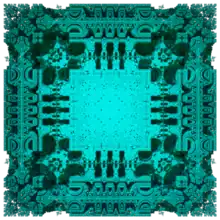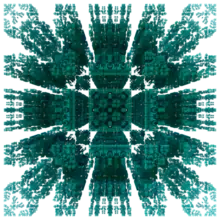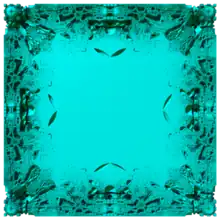Mandelbox
In mathematics, the mandelbox is a fractal with a boxlike shape found by Tom Lowe in 2010. It is defined in a similar way to the famous Mandelbrot set as the values of a parameter such that the origin does not escape to infinity under iteration of certain geometrical transformations. The mandelbox is defined as a map of continuous Julia sets, but, unlike the Mandelbrot set, can be defined in any number of dimensions.[1] It is typically drawn in three dimensions for illustrative purposes.[2][3]



Simple definition
The simple definition of the mandelbox is this: repeatedly transform a vector z, according to the following rules:
- First, for each component c of z (which corresponds to a dimension), if c is greater than 1, subtract it from 2; or if c is less than -1, subtract it from −2.
- Then, depending on the magnitude of the vector, change its magnitude using some fixed values and a specified scale factor.
Generation
The iteration applies to vector z as follows:
function iterate(z):
for each component in z:
if component > 1:
component := 2 - component
else if component < -1:
component := -2 - component
if magnitude of z < 0.5:
z := z * 4
else if magnitude of z < 1:
z := z / (magnitude of z)^2
z := scale * z + c
Here, c is the constant being tested, and scale is a real number.[3]
Properties
A notable property of the mandelbox, particularly for scale −1.5, is that it contains approximations of many well known fractals within it.[4][5][6]
For the mandelbox contains a solid core. Consequently, its fractal dimension is 3, or n when generalised to n dimensions.[7]
For the mandelbox sides have length 4 and for they have length .[7]
See also
References
- Lowe, Tom. "What Is A Mandelbox?". Archived from the original on 8 October 2016. Retrieved 15 November 2016.
- Lowe, Thomas (2021). Exploring Scale Symmetry. World Scientific. ISBN 978-981-3278-55-4.
- Leys, Jos (27 May 2010). "Mandelbox. Images des Mathématiques" (in French). French National Centre for Scientific Research. Retrieved 18 December 2019.
- "Negative 1.5 Mandelbox – Mandelbox". sites.google.com.
- "More negatives – Mandelbox". sites.google.com.
- "Patterns of Visual Math – Mandelbox, tglad, Amazing Box". February 13, 2011. Archived from the original on February 13, 2011.
- Chen, Rudi. "The Mandelbox Set".
.jpg.webp)